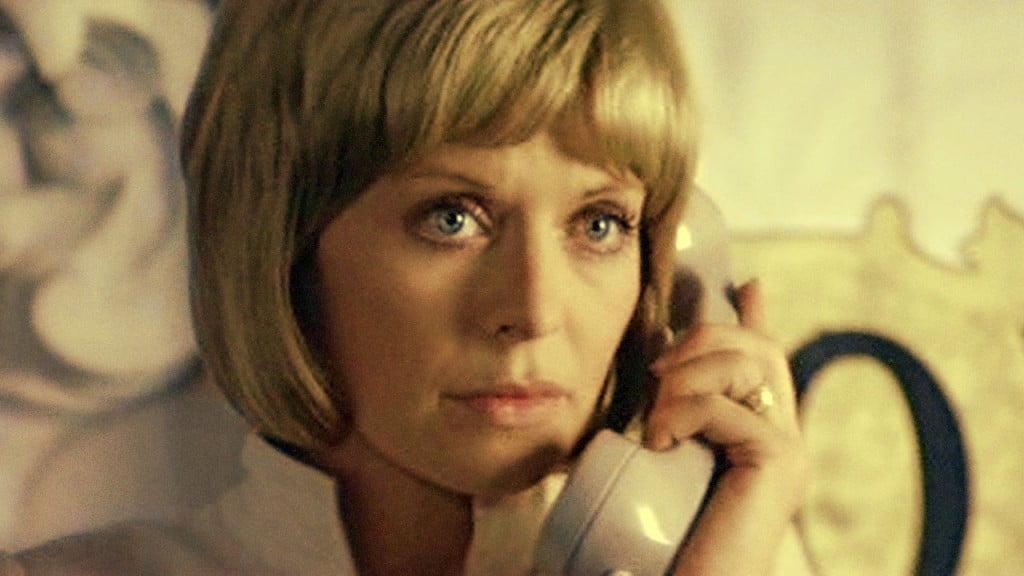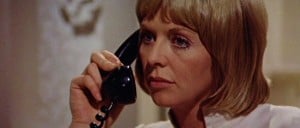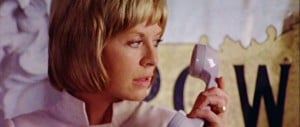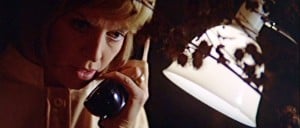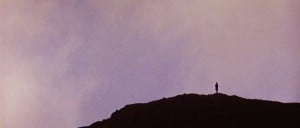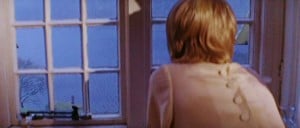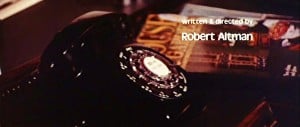Phone Horror (4)
By:
June 15, 2014
[Fourth in a series of 10 posts on representations of the telephone as instrument of fear, conduit of spirits, and messenger of madness. Parts 1-4 are adapted from posts published at the blog The Face at the Window in 2005-06; parts 5-10 will appear here for the first time.]
Images
Robert Altman’s Images (1972) is a spooky contraption, a shivery schizoprism, and among the sleekest of movie enigmas. Yet despite earmarks of success — hot director, international star, plot involving sex, murder, and madness — it slipped between the cracks. Entered in the festivals at Cannes (where its star was voted Best Actress) and New York, it went not only unpraised but largely unreviewed, and those notices that did appear were uniformly negative. Even Pauline Kael, on her way to being the Altman booster par excellence, dismissed it.
Well, see the film; see it, and try to forget it. You’re unnerved from the credits onward. A woman, Catherine, is alone in an expansive two-story cottage located, evidently, in a remote reach of Irish hill country. It will transpire that her husband, Hugh, some unspecified sort of prosperous businessman, is away for the evening. Catherine is writing, thinking, daydreaming, and we hear her words as they run in her head — the text of a children’s book she is composing (titled, the credits inform us, In Search of Unicorns, and written by York herself).
Catherine is languorous among her scattered pillows and pages, serene as she spins the brisk and avid sentences of her preadolescent adventure. That is, until she snaps into some other frame of consciousness — looks right at us, as if suddenly aware of our watching, or bites into an apple that comes up rotten; and at each cut point we cut from Catherine to a sinister still life somewhere in the cottage, objects like cameras and chimes made to look fearsome, like monsters in wait. Accompanying the cuts are the scary, elemental “sound sculptures” of Japanese avant-garde composer Stomu Yamash’ta: explosions of percussion, flute, crazy echo, possessed voices in high cry.
Briiiiiiiinngggg!
The phone! So there is a world beyond these walls. Or is there? Catherine leaves the cottage’s dark, stone-built lower floor and goes upstairs, where the decor is incongruously white, smooth, modernist. The ringing continues. She goes to a black telephone on a low table, sits on the floor next to it — and picks up a nearby book. She leafs through it as if searching for something, meanwhile ignoring the ringing phone. Is she deaf?
The ringing ceases — and almost instantly begins again. This time, though, Catherine snaps to and answers.
Which was the real ring, which the fantasy? Where does reality end and Catherine’s fantasy life begin? What is live, what is Memorex? This stylish uncertainty is the movie’s motor and motive, its game (or “ploy,” as Kael had it), its fun and its fright. An old game; you can vaguely intuit many of the movie’s moves as they come into shape. You’ve seen Don’t Look Now (1973); you may even have seen the Kathleen Turner vehicle Julia and Julia (1988), based on related conceits. Other movies too play these same games, all feeding on each other as neighbors in a subgenre, or installments in a folk tradition, will tend to do. But damned if the game isn’t still fun to play; damned if those moves don’t steal upon you as stealthily as if you’d never once fallen prey to them.
The phone caller is Joan, some obnoxious friend of Catherine’s from town, too much money and liquor in her voice, kvetching because the cat just scratched her boob. Suddenly, mid-kvetch, a new voice — lower, cooler, no booze or humor in it — intrudes.
Hello? it says.
Joan? Is that you?
No. Who did you want?
I was talking to Joan.
Is that you, Catherine?
Yes? Who’s speaking, please?
Don’t you know?
Catherine terminates the call. A moment later, the phone rings again. This time she answers the phone in the bathroom, a white phone. It is the same woman. Her voice grows more familiar as she taunts Catherine about the absent Hugh.
Do you know where your husband is tonight?
Who’s speaking, please?
Laughter.
There is a third phone call. The first voice is Hugh’s, and it coos at Catherine in patronizing tones: economical sketch of a smug prick. Again, the strange woman breaks in — again, laughing. As if she were going slightly mad with laughing. She maintains her taunt, to the point of telling Catherine the name and number of the hotel where she claims Hugh is sheeted down with a mistress.
By now you’ve counted at least four phones in the house, upstairs and down. The heckling voice has run Catherine round to each of them.
Beside herself, Catherine phones the hotel room. Dials nervously in the darkened living room and waits. Busy.
She has barely replaced the receiver before it rings again and again the woman is laughing, baiting Catherine for her credulity, her ignorance.
Catherine listens briefly, puts down the phone, and wanders off. The voice continues in the dark.
From there, Images evolves and unfolds, puzzling and unpuzzling itself. Hugh shows up and proves himself a fastidious twit. He trades off with Catherine’s two lovers — René, an ironic Frenchman, and Marcel, a painter and sexual brute — and the three men circle Catherine in a roundelay, taunting, fucking, evading, their identities morphing in her mind. Hugh steps behind a wall and emerges through a door as René; Catherine smashes lips with Marcel and screams when it is Hugh’s face she sees.
Catherine realizes at a certain point what she must do: free herself from each of these ghosts. She sets about doing this and the film spirals into its heroine’s real madness. Beyond that lies more madness, the last madness — and an ultimate enigma you will find either hauntingly satisfying or as leaden and wince-making as a bowling ball on your instep.
Images falls in that genre that I think of as the ghost story without ghosts. And something that to my knowledge has never been said, but which Images makes obvious, is that Robert Altman — with his roaming camera, layered soundtracks, gift for the mystic ordinary — was one of the great directors of ghost stories.
Look into his golden age: 1969-1977. Start with That Cold Day in the Park, a claustrophobic little creepshow, a modern Gothic, and an important precursor to Images in particular. It’s the Altman style aborning — no fantasist’s haze covering the imagery, but with long passages of near-silence and a concern with the psychosexual frustrations of a plain woman. M*A*S*H (1970) is outrageously sexist and boldly fascist in its admiration of an empty-headed, empty-hearted cool, but turn off the sound and look at the imagery: suddenly the film is all strange faces and indistinct bodies caught on the fly, interactions overhead and flowing past, cold mud and canvas tents made soft as meadows and barns by distance and light. All is transience, and faces are lost in the mist. As something to listen to and think about, M*A*S*H is almost an abomination; as a thing to feel through the eyes, it is amazing, mysterious, a masterpiece.
Skip Brewster McCloud (1971): though Kael did compare its winged hero to the Phantom of the Opera, it’s long reach, short gain. Move on to McCabe and Mrs. Miller (1971) and study its landscape moving from rain to snow, long autumn to endless winter. Look at its many dead, who in the very moments before they die are more alive than we are this second. See if that film — Altman’s masterpiece, one of the greatest movies we have — doesn’t qualify as a ghost story at least as much as it qualifies as a western, or as a love story, or as anything else.
Look at The Long Goodbye (1973) and see how it grips all the necessities of earthy humor, L.A. satire, and revenge scenario while seeming to blow its characters gently about like clothesline laundry in beach breeze, with Marlowe as a wisecracking ghost, the only character not dressed in pastels or prints or hip rags, the only one so utterly out of time that he must end the picture by walking back into the noir past whose symbols won’t let him go — or perhaps into a future that has some place for him.
Look at the parting images of Thieves Like Us, with a clutch of hopeless humans climbing a stairway in some small-town pit of Depression America, slowing to the most unnatural, inhuman slowness, and then simply vanishing. Look even at the mostly affable, materialistic California Split, specifically its regard of Charlie, the Elliot Gould character. Charlie is Philip Marlowe several steps further into the beyond, now more hustle than human, no blood in his veins, only gambler’s juice. Where George Segal, sane man, chooses to step back into life, Charlie lacks that option. He is less man than spirit — a vibrant, life-giving spirit, but also a sapper of souls: a kind of demon lover.
Forget Nashville (1975) in this discussion. Like Brewster, it has no ghosts and is weaker for that. Go to the impeccably designed, dramatically stagnant, yet still fascinating Buffalo Bill and the Indians, or Sitting Bull’s History Lesson (1976). Ghosts walk in and out of the action, mingling with the living, until the end when Paul Newman’s Bill blusters at the immobile spirit of Sitting Bull. Ghosts aplenty in this weird pageant that spends two hours squinting through dust clouds and midday sun, but Altman sees them too easily — points them out, gawking, rather than encountering them, noticing them, breathing quietly with them.
And finally 3 Women (1977), which succeeds, perversely, in being as ethereal as heat waves and as prosaically surfaced as Formica. The story of three women who are ghosts already or are turning into them, and a subject for further study — as is the theatrical trilogy of 1982-84, Come Back to the 5 and Dime, Jimmy Dean, Jimmy Dean, Streamers, and Secret Honor, each a study in isolation and lies, the telling of stories as a summoning of the haunted past.
But none of those movies — with the intermittent exception of That Cold Day — is really creepy, let alone scary. Their ghostliness is of a different kind; it inhabits another dimension of reality, somewhere between the life we know and the death we imagine. And it is comfortable being there: that’s why Altman, when he is in his zone, is so intuitive, so flowing and easy, as if a leaf could not fall in an unpicturesque way, nor an actor draw an inappropriate breath. Images, meanwhile, is unique in Altman’s work because it both feels and fears ghostliness. Catherine’s ghosts wait behind doors and drift in the air. (Literally: wind chimes sound whenever weirdness is afoot.) She looks up and there her ghosts are, be they as near as the next room or as far as the horizon.
Catherine jousts with the ghosts, beds down with them, teases and is teased by them. (She tells René he can’t be real, because he died in a plane crash three years ago. “Oh!” he exclaims, with a droll spread of the arms, “I am a ghost.” Later she throws a heavy trinket at his head, laughing as he hits the floor: “My, my. So the ghost bleeds.”) There is one other ghost, a girl named Susannah, who it is suggested may incarnate a younger version of Catherine herself: this is the heroine’s natural ally, her only friend, the only one about who doesn’t mean her some kind of harm.
The film’s movement is toward Catherine joining with her ghosts, becoming more engaged in the ghost world than the real world — wherever that might be. Catherine has a habit of gazing through windows or peering across waterfalls and seeing herself staring back. Standing on a hill, she spots herself entering the house on the lakeshore below; down on the lakeshore, entering the house, she sees herself up on the hill, far away, a tiny silhouette against the sky. (These shots of women staring at each other over distance, sharing a spectral recognition, recall similar images in Jack Clayton’s The Innocents [1961] — another study of apparent female hysteria manifesting spooks right and left.)
Altman has the spiritual collusion of artists who see the same ghosts. Vilmos Zsigmond photographs landscapes that are like fantasy scenes inside crystal balls: nestled glens and thickening skies, stunning shots from hilltop of long thin clouds moving slowly over a verdant patch of God’s country. John Williams writes an effectively strident score, blending seamlessly with the nightmarish sound sculptures. Leon Erickson’s production design incorporates the rough and the delicate into an aesthetic whole. There is the usual eccentric Altman sound mix, courtesy of Rodney Holland and others, mingling noises so low they hardly register (seemingly sourceless moans, whispers, tinglings, rustlings) with others, natural and artificial, that rip gashes in the silence. The editing of Graeme Clifford is so jagged, spot-on, and mirror-sharp that Nicolas Roeg instantly tagged him as the man to slice Don’t Look Now into life.
Images feels a lot like Don’t Look Now, which I’d nominate as our greatest movie about ghosts. It has that elegance, its objects and surfaces are alive with the same malignity. Both are about characters who believe they can outmaneuver their ghosts, that the empirical will subdue the fantastic, that spooks disappear if mocked or ignored. In both cases, they’re wrong.
Pauline Kael hated both films, and for pretty much the same reasons. She wrote that Images had a style “different from anything of Altman’s I’ve seen before” — and didn’t mean that as a compliment. She meant rather that it was “an empty, trashy chic film … concerned not with why [Catherine] is going mad but with the coquetry of madness.” Well, yes, it is fancy; it is stylish; and it is a game. Games can get in the way, but games can be fun, intriguing, absorbing. Games can be particularly intense ways of passing time — not to mention of reconnecting in adulthood with those sensations that could transport you as a child.
Even Pauline enjoyed “the creepy use of the telephone in the early scenes.”
***
MORE HORROR ON HILOBROW: Early ’60s Horror, a series by David Smay | Phone Horror, a series by Devin McKinney | Philip Stone’s Hat-Trick | Shocking Blocking: Candyman | Shocking Blocking: A Bucket of Blood | Kenneth Anger | Sax Rohmer | August Derleth | Edgar Ulmer | Vincent Price | Max von Sydow | Lon Chaney Sr. | James Whale | Wes Craven | Roman Polanski | Ed Wood | John Carpenter | George A. Romero | David Cronenberg | Roger Corman | Georges Franju | Shirley Jackson | Jacques Tourneur | Ray Bradbury | Edgar Allan Poe | Algernon Blackwood | H.P. Lovecraft | Clark Ashton Smith | Gaston Leroux |

